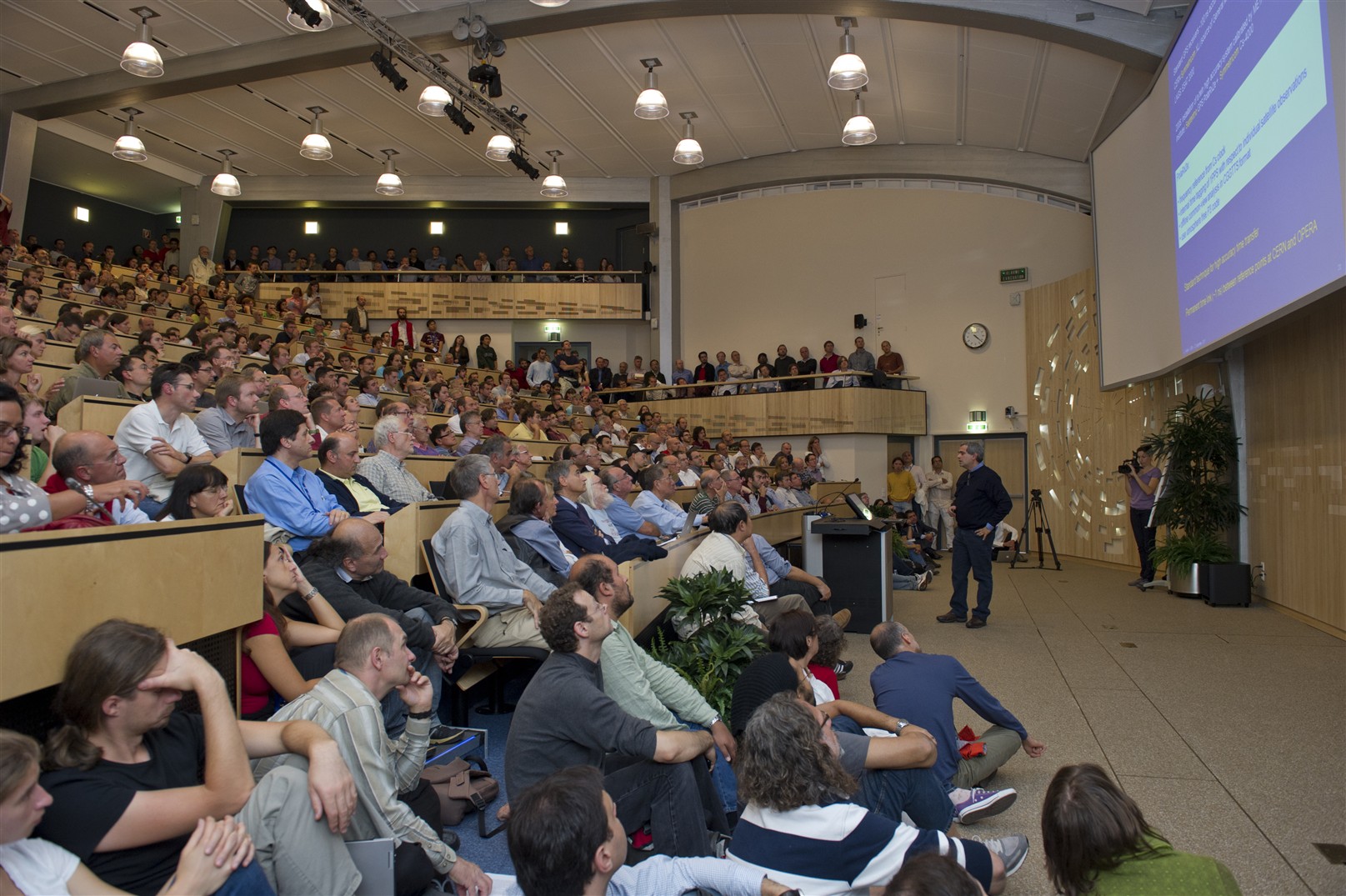Touching base with OPERA
Three seminars – at CERN, at Gran Sasso and in Japan – and an article calling for the scrutiny of the scientific community: the OPERA Collaboration opened its research publicly. In addition to huge press coverage, this triggered welcome reactions from colleagues around the world, many of whom will attempt to independently interpret and reproduce the measurement. OPERA’s Spokesperson touches base with the Bulletin.
The CERN Main Auditorium was crowded as OPERA Physics co-ordinator Dario Autiero presented the results of their research (23 September 2011).
According to the OPERA strategy, the results of the measurements are in the hands of the scientific community and, as for any other scientific result, several months will be needed before other groups will be able to perform an independent measurement. In the meantime, the OPERA Collaboration is dealing with an avalanche of emails from the scientific community, members of the general public, and the press. “We are replying to many interesting suggestions,” says Antonio Ereditato, Professor of Particle Physics at Bern University and Spokesperson of the OPERA Collaboration. “Given the result, we were of course expecting a large response. We are evaluating all the input. Some of the questions concern points that were not explicitly shown during the seminars but will be described in the final version of the scientific paper.”
So far, the main reactions have focused on the Earth’s rotational effects, subtle general relativity issues, the technology used to measure time and distance, and the analysis methods. “After carefully considering all these points, we still have no indication of any large systematic effect that we could have overlooked. However, we are just at the beginning of the screening process by the community and we will have to wait longer,” says Ereditato.
The investigation is just beginning. The OPERA Collaboration is acquiring more statistics to improve the quality of the measurement. Others will do the same in the coming months. “Even if another experiment confirms our result, it will not yet be a discovery but proof that the explanation of such an effect could not be trivial,” says Antonio Ereditato. “We will keep studying the performance of our detector, we will keep looking carefully at the tiny details within the analysis, and we will keep collaborating with colleagues from other experiments. Even if neutrinos seem to travel faster than light, Science must not rush as the understanding of Nature is in no way a trivial exercise.”
| The scientific response |
The Bulletin has contacted some of the experiments around the world that are likely to reproduce the OPERA’s measurement. Here follows their statements:
Borexino
Borexino is installed in the same LNGS underground hall (Hall C), about 20 metres upstream of the OPERA experiment with respect to the neutrino flight direction from CERN. The volume of the Borexino detector is larger than that of OPERA, and Borexino is able to collect a larger number of events produced by CERN neutrinos.
The main goal of the Borexino experiment is the study of solar neutrinos and geoneutrinos. At present, the experiment is not equipped with the special timing devices required to measure the neutrino time-of-flight from CERN with the accuracy required to cross-check the OPERA results, which would be possible only by installing new timing devices.
After preliminary discussions, the Borexino Collaboration has expressed interest in performing an independent measurement to cross-check the result from OPERA. However, the discussion has barely started and is still ongoing. A decision has not been yet been made.
In an optimistic scenario, the Collaboration could be in a position to collect data by the start of the beam run in February 2012, but this depends on the successful implementation of necessary improvements, which cannot be fully evaluated at this time.
LVD
The LVD Collaboration has a great interest in the issue raised by the recent OPERA measurement. The experiment, designed to detect gravitational stellar collapses, can also detect neutrinos from the CERN beam. However, the Collaboration has to evaluate carefully if it can contribute a significant result with their detector as it is, or if it has to change, modify or add some detector parts.
T2K
Based on an initial assessment of the experiment’s current capability, T2K cannot make any definitive statement to verify the OPERA measurement of the speed of neutrino. The Collaboration will assess the possibility of improving their experimental sensitivity in order to cross-check the OPERA anomaly in the future. Such a measurement with an improved system, however, could take a while to achieve.
MINOS
The MINOS Collaboration is planning to improve its measurement of the neutrino time-of-flight since its last result in 2007, with better-controlled systematics and about 10 times more data. The first update should be in about 6 months. There will be a further improvement (which was already planned) for the MINOS+ experiment, starting in 2013, which will take very high statistics, and higher energy data. This should give a total error of 5-10 ns on the final measurement.


